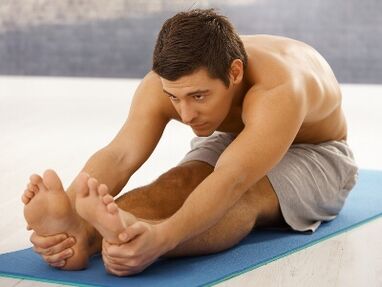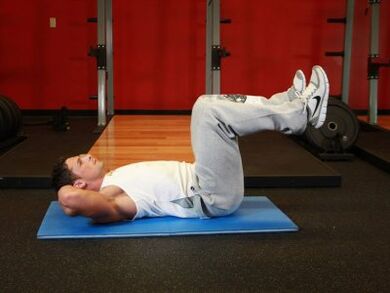
Prostatitis and benign prostatic hyperplasia are relatively common diseases in the older male population.
The main symptom of prostate adenoma is difficulty urinating due to urethral compression.
With this disease, in the framework of complex treatment, along with drugs, folk remedies, for example, the use of dead bees for prostate adenoma, and surgical methods, as well as to prevent congestion and inflammation, therapeutic exercises are recommended.
Special training for prostatitis and prostate adenoma should be done for a considerable time. They are intended to strengthen the muscles of the pelvis, perineum, lower legs, general strengthening of the body.
Also, exercise recommended for prostatitis and prostate adenoma is indicated to a man after surgery on the prostate gland to avoid complications. In this case, they should be carried out in a gentle manner and take into account the well -being of the patient.
Physiotherapy for prostate adenoma: the main complex of physical exercise

Physical therapy for prostate adenoma, as well as massage, improves blood circulation in the pelvic organs.
This can stop the progression of pathological processes, reducing the growth rate of benign tumors.
Exercise for prostate adenoma includes static and dynamic exercise.
General strengthening exercises, such as walking, running, cycling, are referred to as dynamic exercises. It is also worthwhile to do exercises such as squatting, walking on the back, rolling on a ball, exercising by lifting and raising the legs, or raising the pelvis while lying down.
Static exercises include a standing position with prolonged tension of certain muscle groups.
It is useful to note
Strengthening the back and abdominal muscles is important. For this, the exercises are carried out in a supine position, on the sides, on the abdomen, twisting and push -ups. One of the effective exercises is to bike in the supine position, to complicate the exercise - with the pelvis raised.
All kinds of lifts and inclinations, pelvic rotational movements are useful. There are special training sets aimed at the perineum muscle groups.
The most well -known and effective set of exercises for prostate adenoma is the Kegel complex, created by gynecologists for women and modified for men. The main exercises performed are standing and lying down, consisting of anal and perineum muscle exercises, aimed at preventing congestion in the perineum and small pelvis.
The complex should be done in the morning, after hygiene procedures, and in the evening. Bedtime exercises with prostate adenoma are recommended to be done 2-3 hours before bedtime.
notes
Exercise for prostate adenoma should be carried out taking into account the well -being of the patient, one should not burden and force progress, the complexity of training must necessarily take into account the age of the patient and agreed with the attending physician.
A properly selected set of exercises after surgery on the prostate gland can be an important aid during the postoperative recovery period. Exercise should be regular.
The set of exercises itself does not take much time, but its frequent use has a beneficial effect on the general condition of the male body and blood circulation in the pelvic organs, reducing the severity of congestion and edema.
Also, strengthening the abdominal and perineum muscles has a positive effect on the process of urination, and in the future will be an excellent prevention of prostate adenoma.
important
It should also be remembered about the simplicity in doing the exercises, they should bring pleasure and a little fatigue, but should not be accompanied by painful sensations or done through force.
Therapeutic gymnastics for prostate adenoma

Gymnastics recommended for prostate adenoma is performed not only for benign prostate hyperplasia, it can also be useful for patients who have undergone surgery for prostate cancer in chronic prostatitis.
Physical therapy in combination with drug therapy can help reduce edema and congestion in the small pelvis, and, thus, reduce urethral obstruction and increase urine output. Therapeutic gymnastics for prostate adenoma, or exercise therapy, is carried out under the supervision of a specialist doctor, in groups, often in medical institutions and includes three stages.
In the first stage, general physical activities are provided, including aerobic exercise, running, jumping, and warming up.
In the second stage, special exercises are carried out aimed at strengthening the back muscles, abdominal muscles, perineal area, the muscles that contribute to the emptying of the bladder. Various exercises are also performed to reduce congestion in the pelvic organs.
In the third stage, stretching and relaxation of the muscles loaded during exercise is achieved.
notes
This training course to get a stable effect should be carried out regularly and take a long time. Physiotherapy training techniques must necessarily be incorporated into the complex of therapeutic measures, including drug treatment, and physiotherapy, and surgery, if necessary.
Reproduction of prostate gland tissue is an age -related disease, and its course is highly dependent on the state of health and safety of the body.
Adherence to the rules of a healthy lifestyle, regular exercise, proper nutrition and adherence to diet, avoiding bad habits have a significant impact on quality of life and have a positive impact on both the onset of the disease and its course.
The habit of maintaining physical activity and the use of available exercises, even in old age, allows you to maintain the function of organs and systems for a long time.
























